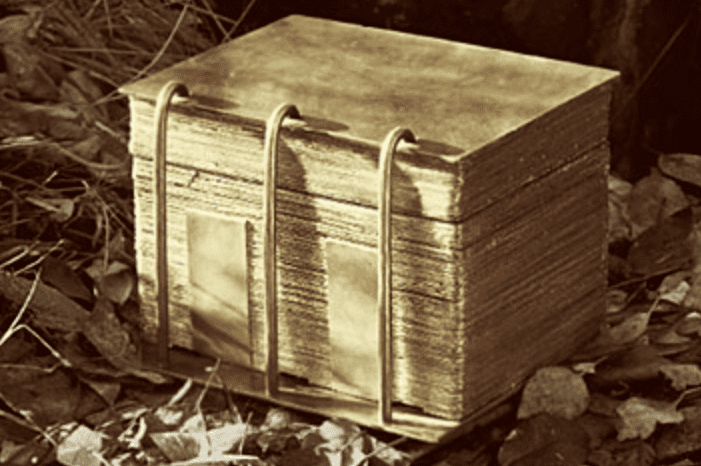Nearly 200 years ago, on September 22, 1827, Joseph Smith claimed to have recovered an ancient record, engraved on gold plates, from a hill near Palmyra, New York. He had been led to the record by an angel four years earlier, and more than two years after he had taken the plates from the hill, he published the Book of Mormon as a translation of that record revealed to him by the gift and power of God. Eleven witnesses affirmed the historical reality of those plates, and though some left the church, all of them went to their graves testifying that they had seen the plates.
For two centuries, debate has raged as to whether Joseph really possessed and translated an ancient record, and in recent years, a new argument has been gaining traction: the Book of Mormon, some detractors claim, is too long to fit on the gold plates as described by Joseph Smith and the witnesses. Some of the biggest names in online discussions about religion, such as Catholic apologist Trent Horn and skeptic influencer Alex O’Connor, have raised questions about the feasibility of fitting the entire 270,000-word text of the Book of Mormon onto the unsealed portion of a six-inch stack of 6 x 8-inch plates.
A response to this claim by Josh Coates, the executive director of the non-profit B. H. Roberts Foundation, was presented at the 2025 FAIR conference in August and published in the Interpreter journal earlier this summer. Using descriptions of the plates given by the witnesses to establish his parameters, Coates literally did the math and found nearly one million configurations in which the entire text of the Book of Mormon—including the lost 116 pages—could fit onto a set of plates consistent with the historical record.
Yet some may still wonder how feasible it would be for ancient scribes and metalworkers to create a record consistent with the configurations produced by Coates, which require nearly 200 plates, each less than two-thousandths of an inch thick and written over in characters less than six millimeters in size.
To answer this question, I’ll compare three parameters discussed by Coates to artifacts found in the Old and New Worlds: (1) the size of the writing, (2) the thickness of individual plates, and (3) the total number of plates. A more in-depth review of this and other evidence can be found in my paper recently published by FAIR, where I comprehensively compared all the dimensions of the gold plates to archaeological discoveries.
Size of Writing
Coates found that the script on the plates could be no larger than 5.4 mm per character, while some configurations required the script to be as small as 2.5 mm per character. (For reference, 12-pt font is typically about 2–3 mm per character.) This may seem impossibly small, but there are numerous examples of metallic inscriptions from the ancient Near East written in script between 2 and 5 mm.
One of two small silver scrolls found in Jerusalem, and dated to 600 BC, has an average script size of 5.4 mm per character. The other, smaller scroll was engraved with characters an average of 3.25 mm in size. The Assyrian king Sargon II (ca. 722–705 BC) commissioned inscriptions onto tablets of silver and gold with characters around 4.5 and 3.5 mm, respectively. An earlier Assyrian king, Tukulti-Ninurta I (ca. 1243–1207 BC), commissioned a gold tablet inscribed with characters a mere 2.2 mm on average. Several other Assyrian inscriptions on gold and silver are known with writing between 3.4 and 4.5 mm.
Admittedly, many of these are relatively short inscriptions on small surfaces, but small writing was used on longer inscriptions, too. An unusually large silver amulet found in Egypt features a 38-line text that translates to nearly 1000 words, written in a small script averaging 1.6 mm per character. A Hittite treaty was engraved onto a large bronze tablet with over 350 lines and 4000 words in its English translation, written in characters that are on average 3.5 mm tall. A Roman legal code, approximately 20,000 words in its English translation, was engraved onto 10 large bronze tablets in Latin characters, an average of 5 mm in height.
The overall average character size across 24 metallic inscriptions I have examined is about 3.4 mm. Writing between 2–5 mm, then, was well within the capabilities of ancient Near Eastern scribes when writing on metals.
Thickness of Individual Plates
Several witnesses compared the thickness of the individual plates to “common tin” of their day. In the early nineteenth century, commercial tin-plate could be between 0.012–0.02 inches thick, with the most commonly available being 0.019 inches, according to Coates’ research. Coates, therefore, used 0.015–0.019 inches as his parameters for plate thickness. Others, such as geologist and engineer Jerry Grover, have argued that the plates could have been even thinner—between 0.005–0.01 inches—based on some witness statements that indicate the plates were “pliable” and comparable to thick paper.
But were pre-Columbian metalworkers capable of making such razor-thin plates? Yes. Gold-copper alloy discs from Nariño, Colombia, ranging from four to six inches in diameter, were measured to be generally about 0.012–0.02 inches thick, exactly the range of nineteenth-century tin plates. A fifth-century gold-copper alloyed bead found in Mesoamerica was made of hammered sheet metal between 0.012 and 0.016 inches thick. Similarly, a golden ornamental plume from Peru, dated to Book of Mormon times, is between 0.012–0.016 inches thick, and has an intricate design engraved on both sides, illustrating that plates this thin could be inscribed on both the front and back.
Even Grover’s estimates for pliable, paper-thin plates are supported by ancient artifacts. Golden crown-like diadems, “fabricated of flexible sheet metal that bends easily,” observes Julie Jones, are “among the earliest worked gold objects from South America.” Heather Lechtman examined gilded copper artifacts from northern Peru, dated to the early centuries AD, which had “edges that were paper-thin.” According to expert Warwick Bray, Peruvian goldsmiths could hammer gold-copper-silver alloys into a thin sheet merely 0.008 inches thick.
So archaeology confirms that thin plates made of gold and copper, comparable to the thickness of nineteenth-century tin or pliable, thick paper, could be manufactured in the Americas during Book of Mormon times.
Total Number of Plates
Even with small writing, the length of the Book of Mormon requires a large number of plates in order to fit on the unsealed portion, and if the plates are really only fractions of an inch thick, there would be hundreds in a six-inch stack. Coates’ calculations resulted in a range of 187–259 plates in the entire stack, while Grover, assuming the plates could be thinner, ended up with even higher estimates of 300–600 plates. Such a large volume may seem unrealistic, but once again, ancient examples of similar size abound.
I already mentioned the Roman legal code on 10 bronze tablets, dated to the first century AD. These tablets are each nearly two feet long and three feet wide—spanning 30 feet across when mounted side-by-side. The total surface area of these tablets is equivalent to 170 Book of Mormon plates of 6 x 8 inches each, as described by witnesses.
Matthew Roper, writing for Scripture Central, mentions several large sets of engraved copper plates, bound together by rings, from ancient and medieval India. One set of 57 plates, each about 16.3 x 9 inches, has a total surface area comparable to 174 Book of Mormon plates. Another set consists of 86 plates, each 17.3 x 8.3 inches, equivalent to 258 Book of Mormon plates. Roper has also identified a copy of the Quran found in China, engraved on 604 gold-gilded copper plates about 4.3 x 6.3 inches each, equivalent to 343 Book of Mormon plates.
Although not bound together as a set, a corpus of nearly 800 ancient Hindu hymns engraved on 493 large plates was discovered in India in 2023. These plates are nearly 27 inches long and 3 inches wide, making their total surface area comparable to 812 Book of Mormon plates.
Clearly, a large volume consisting of hundreds of metal plates is not outside the scope of attested historical practice.
Why Does This Matter?
The parameters required to fit the Book of Mormon onto the plates, as established by Coates and others, may seem extraordinary. Individually, however, each parameter is abundantly attested in archaeological discoveries. Still, the unique combination of small writing across hundreds of razor-thin plates should deepen our appreciation for the consecrated effort that went into making and preserving this sacred record.
Jacob noted “the difficulty of engraving our words upon plates” (Jacob 4:1), and Moroni lamented “the awkwardness of our hands” (Ether 12:24). These words gain greater meaning as we better understand the physical details of how many plates were needed, how thin the plates had to be, and how small they had to write to fit every word of this powerful testament of Christ.
With the recent the anniversary of Moroni’s visits earlier this week, it is worth reflecting on the generations of sacrifice required to engrave the Book of Mormon onto the very gold plates commissioned into Joseph Smith’s care on September 22, 1827, as well as how nearly 200 years’ worth of scholarly discovery now enables us to not only address challenges to our faith, but to also increase our gratitude for those who “labor[ed] diligently to write” (Jacob 4:3).
Neal Rappleye is a research associate for the Ancient America Foundation, and co-host of the newly launched podcast, Informed Saints. He has published widely on the ancient background of the Book of Mormon in Latter-day Saint academic venues. Through Informed Saints, he and his co-hosts seek to bring academic research on Restoration history and scripture to life in new and exciting ways for larger audiences.




















